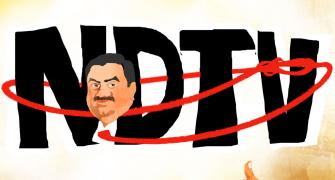Lower international interest rates during June-July 2002-03 led to a sharp fall in returns on India's foreign currency assets to 2.8 per cent compared to 4.1 per cent during FY02 while that on gold reserves it fell to 0.6 per cent from 0.9 per cent.
| |||||||||||
In a first report of its kind on forex reserves, the Reserve Bank of India said similar to international practices, the country's forex reserves were invested in multi-currency, multi-market portfolios as per the existing norms.
At the end of September 2003, India's forex reserves stood at $91.13 billion, up from $5.8 billion as on March end 1991, RBI said in its report released in Mumbai on Tuesday.
On gold reserves, RBI said that it holds 357 tonnes, forming about 4.3 per cent of the total reserves as on September 30, 2003. Of this, 65 tonnes was held abroad since 1991 in deposits with Bank of England and Bank of International Settlements.
Out of the total foreign currency assets of $87.2 billion, $31.7 billion was invested in securities, $9.6 billion with other central banks and BIS and $15.8 billion in the form of deposits with foreign commercial banks.
Finance Minister Jaswant Singh in his Interim Budget on Tuesday said the country's forex reserves had crossed $100 billion on December 19, 2003 and that RBI would release the data.
RBI said in order to bring about transparency and enhancing the level of disclosure it would compile half yearly reports on management of foreign exchange reserves with reference to position as on March 31 and September 30 with a time lag of three months.
The report said India's current account deficit, which was as high as 3.1 per cent of GDP in 1990-91, turned into a surplus of 0.7 per cent in 2002-03. A small surplus of $207 million was posted in the current account during the first half (April-September) of 2003 04, driven mainly by the surplus in the invisible account, it added.
Referring to sources of accretion, the central bank said the increase in forex reserves in the recent period has been on account of capital and other inflows.
The major sources of increase in forex reserves have been foreign investment, banking capital, increase in other types of capital inflows, short-term credit and valuation changes.
RBI said an analysis of the sources of accretion since 1991 revealed that it had been facilitated by an increase in the annual quantum of foreign direct investment from $133 million in 1991-92 to $4.7 billion in 2002-03.
During April-September 2003, the quantum of FDI inflows was to the order of $1.6 billion. Outstanding NRI deposits increased from $13.7 billion at end-March 1991 to $31.3 billion at end-September 2003, it said.
Cumulative net FII investments into the Indian capital market, increased from $827 million at end-December 1993 to $19.2 billion at September end 2003.
Turning to the current account, India's exports which were $17.9 billion during 1991-92 increased to $52.7 billion in 2002-03.
Invisibles, such as, private remittances have also contributed significantly to the current account which increased from $1.6 billion in 1991-92 to $ 17 billion in 2002-03.
During six months ending September 2003, net invisible inflows amounted to $12.3 billion, it added.
RBI said the significant increase in forex reserves enabled repayment of high cost foreign currency loans to Asian Development Bank and World Bank amounting to $3.03 billion during February 2003.
Resurgent India Bonds aggregating $5.5 billion, including the interest, were redeemed on October last year without causing any impact on the domestic liquidity, money market or on the forex market.







